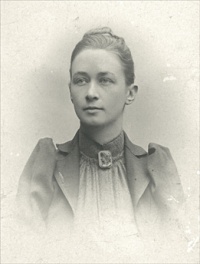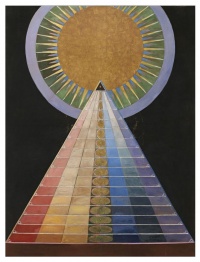Hilma af Klint

Hilma af Klint, (October 26, 1862 – October 21, 1944) was a Swedish artist and mystic whose paintings were amongst the first abstract art. A considerable body of her abstract work predates the first purely abstract compositions by Kandinsky.
Early Life and Education
Hilma af Klint was born in Sweden on October 26 1862, the fourth child of Captain Victor af Klint, a Swedish naval commander, and Mathilda af Klint (née Sonntag).
At an early age she showed signs of artistic aptitude, though her true interests included mathematics and botany. When the family moved to Stockholm, af Klint studied at the Academy of Fine Arts of Stockholm, where she learned portraiture and landscape painting. At the age of 20, she was admitted to the Royal Academy of Fine Arts and during the years of 1882–1887 she studied mainly drawing, portrait and landscape painting. She graduated with honors and was given studio space in the Atelier Building as a scholarship. Hilma af Klint began working in Stockholm, gaining recognition for her landscapes, botanical drawings, and portraits, providing a source of income.
Artistic Career
The Five
Around the age of seventeen, af Klint became involved in spiritualism. She became interested in Theosophy and the philosophy of Christian Rosenkreutz, then later anthroposophy developed by Rudolf Steiner.
Theosophical Society involvement
On May 23, 1904, Miss af Klint joined the Stockholm Lodge of the Theosophical Society headquartered in Adyar, Chennai, India.[1] There is evidence that she participated in a Swedish lodge as early as 1889, but little is known about that earlier involvement.
Her art definitely had a Theosophical influence. By the late 1870s she began to participate in séances, and soon developed an interest in Theosophy and the occult, as would be the case of Mondrian and Kandinsky some years later.
Hilma af Klint was only introduced to a wider audience at the 1986 The Spiritual in Art exhibition. She was trained and initially worked as a conventional artist, but in the 1890s af Klint participated in Spiritualist sessions and started to draw under the influence of spirits. She owned a Swedish edition of Blavatsky's Secret Doctrine and Theosophical ideas quickly gained ground within these sessions. Between 1905 and 1907 af Klint realized a first series of esoteric paintings, called "drawings for the temple," created under the guidance of a spirit called Amaliel. After meeting [Rudolf] Steiner in 1908 she ceased painting to study Anthroposophy, eventually returning to and finishing the temple-series between 1912 and 1915. The series explores the major Theosophical theme of the cosmic dynamics between male and female and their eventual unity, also central to Mondrian's work. Her works are, notably, abstract. Similarly to the other artists associated with Theosophy, form (mostly abstract) was of prime importance to af Klint, as well as a particular symbolism of color; for her blue, the lily, and the eye represented femininity; yellow, the rose, and the hook masculinity (Lampe 2008: 130). She never exhibited during her life and left an oeuvre of over 1,000 paintings (Rousseau 2008).[2]
Additional resources
- Seven articles about Hilma af Klint are listed in the Union Index of Theosophical Periodicals.
- "Art and About: Hilma af Klint".
- Bax, Marty. "Hilma and the Enigmatic Mathilde N." Bax Art Concepts & Services blog. October 4, 2013. Available at Baxpress.blogspot. Viewed October 21, 2016.
- Hilma af Klint: Painting the Unseen at the Serpentine by Louisa Buck for The Telegraph.
Notes
- ↑ Theosophical Society General Membership Register, 1875-1942 at http://tsmembers.org/. See book 2, entry 25914 (website file: 2C/66).
- ↑ Tessel M. Bauduin, "Abstract Art as 'By-Product of Astral Manifestation': The Influence of Theosophy on Modern Art in Europe" Handbook of the Theosophical Current (Leiden: Brill, 2013),440-441.

